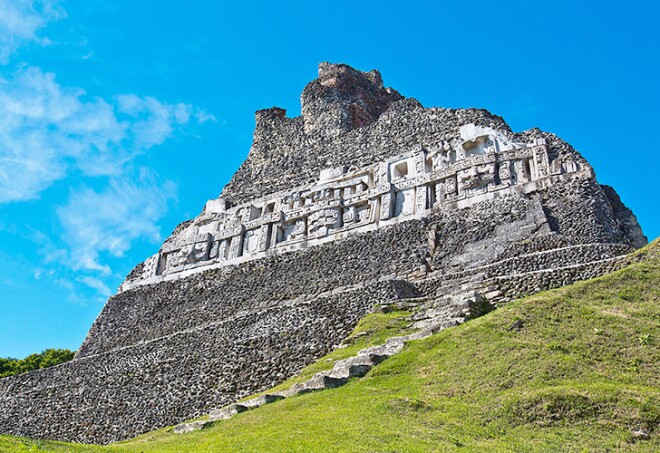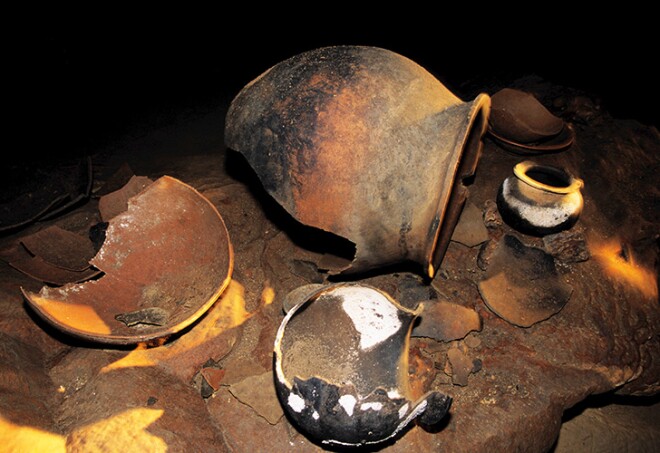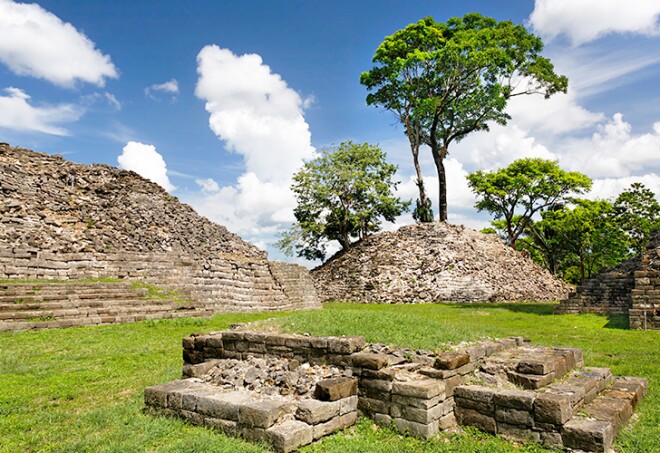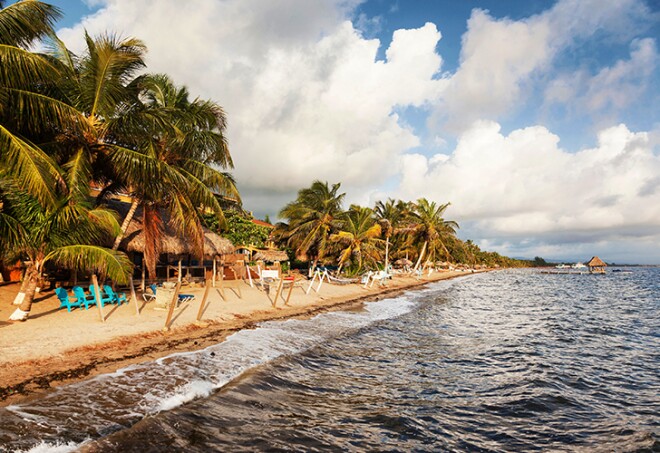161 Dolphin Trail Long Caye, Lighthouse Reef, Belize
One of three atolls in Belize, Lighthouse Reef Atoll is blessed with a handful of the most prized natural sights along the Belize Barrier Reef. The Great Blue Hole attracts divers eager to add a notch to their diving belt by exploring an underwater cavern more than 400 feet deep. On shore, Half Moon Caye Natural Monument, the country’s first protected site, is a turtle-nesting beach dotted with towering palm trees and no permanent inhabitants save for hermit crabs. Last but not least, you can view a thriving red-footed booby sanctuary, the only one in the Western Hemisphere aside from the Galápagos. It’s no wonder Lighthouse Reef is a popular day-tripper choice, whether you dive, snorkel, or simply love nature.
Xunantunich Rd, Belize
The Cayo District is home to many of Belize’s ancient Maya sites, including one of the largest, Xunantunich. Located atop a ridge near the Mopan River and the Guatemala border, Xunantunich’s “El Castillo,” the main pyramid, is certainly the most impressive. Visitors who brave the steep steps to the top are rewarded with unsurpassed views into Guatemala and neighboring areas of Belize. While the climb up can be pretty steep and rough, there are other routes to get down along the backside that make the descent a little easier. It took me multiple visits to finally gather the courage to climb to the top, but I’m grateful I did, as the views were absolutely worth it! Organized tours to Xunantunich often combine with other activities like zip-lining, cave tubing, or even trips to the Belize Zoo. Travelers who wish to explore all of Xunantunich’s six plazas, which contain more than 26 temples and palaces, should plan to book a private tour or visit on their own.
Western Highway (Westbound)
On the banks of the Macal River, at the edge of downtown San Ignacio, you’ll find a sprawling Saturday market where everything from shoes and clothing to housewares and fresh produce is for sale. Local people shop for supplies and gather to catch up on gossip at the food stalls. The market is somewhat divided between produce sellers and souvenir vendors, but as the market has grown, the separation seems to have floundered a bit. Leave enough time to wander every aisle and stall to ensure no gem is left undiscovered. Locals recommend the tacos and pupusas as the best choices for lunch, and the snow cones topped with evaporated milk for a snack. Buses also park just next to the market in a dirt lot, so transportation is not difficult if you’re coming from outside of town.
Belize
If you’re impressed by the jungles and rivers surrounding San Ignacio, you’ll be in awe of the contrasting landscapes as you head south from town. Mountain Pine Ridge Forest Reserve, a wide-open expanse of jungle, rocks, waterfalls, and caves, is reached by a dirt road lined with towering pine trees. Staying in a remote lodge in the reserve area is as romantic as it gets, but even a day trip has its rewards. Take a dip in fresh water after hiking to uncrowded waterfalls like Big Rock, or swim at Rio on Pools, a swimming hole fed by cool, cascading waters. This reserve is one of Belize‘s grandest wild landscapes.
Belize
Often called ATM Cave, Actun Tunichil Muknal (the Cave of the Crystal Maiden) is one of the most popular adventure excursions in Belize. Visitors hike dense jungle trails for an hour and a half to reach the mouth of the cave, then enter and wade through dry and wet caverns, spelunking past pottery shards and human sacrificial remains. The adventure ends with a steep ladder climb into a narrow passageway to reach the chamber where a full female skeleton rests. It’s spooky, surreal, and magnificent.
While every major cultural group in Belize celebrates its own festivals and rituals, one of the most unifying festivities is Garifuna Settlement Day, which is also a national holiday in Belize. Celebrated on Nov. 19, the day marks the arrival in 1823 of the Garinagu people to the shores of Belize. Head to Dangriga the evening before, when vibrant celebrations begin in town. Locals and visitors from all over Belize and the world gather under the thatch-roof sheds to dance and chant to Garifuna drums until sunrise. Canoes are filled with cassava leaves and traditionally clothed residents, who paddle their way to shore while those waiting along the banks cheer. Once the canoes reach shore in the morning, the revelry continues in the streets of Dangriga all day long, with a traditional church service, followed by street parades and dancing.
Silk Grass, Belize
Tucked down a long and bumpy dirt road on the way to Hopkins, Mayflower Bocawina National Park is a well-maintained nature escape offering a variety of adventures, from the casual to the extreme. Decide how brave you feel and choose from the options: hiking and birding along moderate trails to waterfalls; a two-hour, steep, adrenaline-pumping hike, with the occasional rope to climb, to the breathtaking 1,000-foot-high Antelope Falls; zip-lining across the park day or night; or rappelling 150 feet down a couple of waterfalls. Fill up afterward at the on-site restaurant before hitting the road, or book an overnight stay at the park’s cozy cabanas.
Punta Gorda, Belize
Head to the deep southern end of Belize and you’ll find yourself in a world of Maya villages. Belize’s first inhabitants continue to live traditionally in the countryside in beautifully thatched homes, close to rivers, cooking by fire hearth, and practicing their medicinal and spiritual beliefs. You can immerse in Mayan culture by doing a homestay, or better yet, spend a full day in Indian Creek Village with EcoTourism Belize—a sustainable tour company that reinvests 100 percent of tour monies into the area’s conservation programs. During the visit, you’ll learn about the Maya way of life, make caldo and tortillas for your lunch, and spend the afternoon hiking and swimming in the river.
New River Lagoon, Belize
New River Lagoon, more than 25 miles long, runs through the heart of the northern province of Orange Walk, one of Belize‘s most untouched and green landscapes. Several companies offer safaris, during which you can observe the wilderness from the comfort of a speedboat, gliding along the mangrove-lined banks. This district is home to Morelet’s crocodiles, river turtles, howler monkeys, and numerous bird species—including the Jesus Christ bird, or jacana, which appears to walk on water. The boat ride ends at Lamanai archaeological site, for more hiking and wildlife-spotting on shore.
Belize City, Belize
Belize’s liveliest time of the year comes in September, when the entire country celebrates independence for three entire weeks leading up to Sept. 21. The major towns and cities host various events, and a countrywide calendar is published on Sept. 1, allowing you to follow along with the fun wherever you might find yourself in Belize. The most popular events are a steel pan concert called Pan Yaad, held in Belize City, and two full-blown carnival parades. Belize City Carnival, with soca and Caribbean music blaring, is held in mid-September, while Orange Walk Carnival takes place on Independence Day and celebrates Mestizo heritage. Take advantage of low-season fares to get a unique culture-filled experience in Belize in September.
On approach, Laughing Bird Caye is breathtaking: a narrow island, lined with multiple palm trees, with a single thatch hut where a resident park ranger awaits to welcome and inform visitors. It’s not so bad once you’ve arrived, either: brilliant white sand, iridescent turquoise water, pelicans overhead. This 10,000-acre protected marine park is more than a sight for sore eyes: It offers some of the best snorkeling in Belize, particularly on the leeward side of the island where large tropical critters thrive. Barracuda, nurse sharks, bonefish, and rays swim alongside smaller fish in colorful, healthy corals. Laughing Bird Caye, part of the Belize Barrier Reef and a designated World Heritage Site, is a popular snorkel day trip from Placencia Village, just 11 miles away.
Placencia Peninsula, Belize
The southern Placencia Peninsula is a laid-back beach destination where you’ll see a little bit of every Belizean cultural group, in addition to a healthy number of expats. The village is where the action is, a main drag lined with Creole restaurants, bistros, fruit stalls, and snack stands. North of the strip, resorts occupy the Seine Bight and Maya Beach areas, ranging in scale from boutique to large, with swimming pools and water toys. Placencia is near some of the most gorgeous diving and snorkeling in Belize, including dreamy islands for day trips—such as Ranguana Caye, Laughing Bird Caye, and the Silk Cayes.
Hopkins
Hopkins Village is a coastal escape with a perfect balance of culture, local and international dining, and some of the best accommodation options in the country. Once a remote Garifuna fishing village, Hopkins has become a full-fledged tourist destination without losing its local flavor. You’ll find yourself immersed in the Garifuna way of life, laid-back during the day and alive at night. The village’s main stretch of beach is one of the safest in Belize, even if the sea isn’t that typical turquoise hue. Inland, explore a host of activities ranging from Garifuna drumming classes at Lebeha Drumming Center or cooking classes at Palmento Grove Cultural & Fishing Lodge to hiking at nearby Mayflower Bocawina National Park. Nights bring options for drinks and dining—try a Garifuna restaurant, but also treat yourself to alfresco gourmet meals at Chef Rob’s. Weekly drumming nights are popular on the beach, as is gazing at the stars from your hammock.
Mile 29 Western Hwy, La Democracia, Belize
This zoo in incredible for a few reasons: obviously, primarily for the animals there. Being in Belize, there are jaguars, ocelots, scarlet macaws... everything you wish you could stumble upon when hiking in the rainforest (if only hiking boots were less noisy!). Most noteworthy perhaps are the scarlet macaws, which are endangered. If you like to research places before visiting, you MUST read, The Last Flight of the Scarlet Macaw by Bruce Barcott: it tells about the Scarlet Macaw, Belize itself, and Sharon Matola- the woman who started the zoo and fought to save the macaws a while ago. If you’re lucky, you might even be able to hold a boa constrictor (I did!) or meet Matola, who my friends ran into while touring the zoo.
Turneffe Atoll, Belize
Turneffe Atoll’s sprawling central lagoon is a beautiful natural playground marked by thick mangrove islands and littoral forest, and hosts dozens of remarkable marine species – including crocodiles. Yes, the central lagoon is pretty to look at and one of the best places in Belize to watch the sun rise, but I wouldn’t recommend you go for a dip. Crocodiles spend their days escaping the heat in the thick mangroves, then swim out into the open ocean at dusk to feed. I saw two crocs during my time on the island; a very young juvenile whose curiosity had brought him right up to the sandy patch of beach behind the Blackbird Caye Resort, and a suspicious adult who kept his distance (thankfully). Still, the lagoon is a great place to spy on the aforementioned crocodiles, photograph marine birds, and more. Photo Finish: Nikon D800 | 24-70mm f/2.8 lens | Aperture f/6.3 | ISO-400 | Shutter 1/60 sec.
Belize
In the Orange Walk district, in Northern Belize, lies one of the largest Maya ruins in the country: Lamanai. It is accessible by road but I arrived after a one-hour boat ride up the New River. The name “Lamanai” is roughly translated as “Submerged Crocodile.” Apparently, there was once a thriving population. The ruins may date back to 700 B.C. and estimates put the number of structures, which are part of the ruins, at around 700 buildings; however, less than 5% has actually been excavated. Thick jungle, filled with howler monkeys, birds and jaguars, conceal the remaining structures. The walk through the jungle from the landing dock is certainly evocative. Tall palm trees form a dense ceiling and thick underbrush conceals everything around the path, still littered with pottery shards and artifacts because excavation is still ongoing. The Mask Temple has the most well preserved details but the view from the top of N10-43 (or High Temple) is thrilling. I don’t recommend it for those who are afraid of heights because the climb down is steep and challenging. If you can make it, it’s worth every moment of struggle. I am no expert judge, but I would revisit Lamanai again in a heartbeat; of all the Maya historical places I have been, it was the most interesting and complete in terms of narrative and historical detail. A museum toward the entrance to the complex could easily take an entire afternoon to get through because of the volume of information it houses.
Western Highway San Ignacio town, San Ignacio, Belize
On a hill just above the town of San Ignacio, on a site that only covers about two acres, lie the Maya ruins of Cahal Pech. Like so many of the Maya sites around Belize, steps have been taken to ensure that what remains is preserved and that visitors are able to explore structures at their leisure. The name apparently means “place of ticks” and was chosen because the area around the ruins was used as land for grazing animals. Cahal Pech, settled in 1000 BC and no longer inhabited by 800 AD, was a royal palace for a ruling Maya family, and the site consists of seven plazas plus structures that include temples, a ball court, homes and an altar. Not all of the ruins are in excellent shape but climb to the top for wonderful views of the surrounding river valley. There is also a visitor center and museum on site.
Crooked Tree, Belize
The Northern Jacana, the elusive Sungrebe and the Yellow-Headed Parrot are all easily found within the boundaries of the Crooked Tree Wildlife Sanctuary’s 16,400 acres. It is a birding destination, and considered to be a globally significant wetland. Belize has the largest nesting population for the Jabiru Stork and Crooked Tree is an excellent place to spy on the famous resident. The surrounding communities play host each year to celebrations that are part of World Wetlands Day. A bus can bring you to Crooked Tree from Belize City every day except Sunday and the sanctuary is located three miles off the Northern Highway, about 30 miles from Belize City or Orange Walk. The sanctuary is open 8 a.m. to 4:30 p.m. and offers horseback riding, boat tours and hiking for those not strictly interested in bird watching.



























